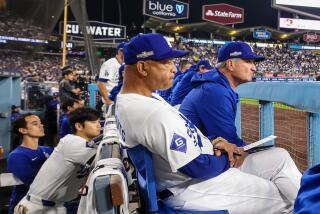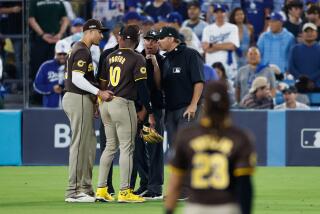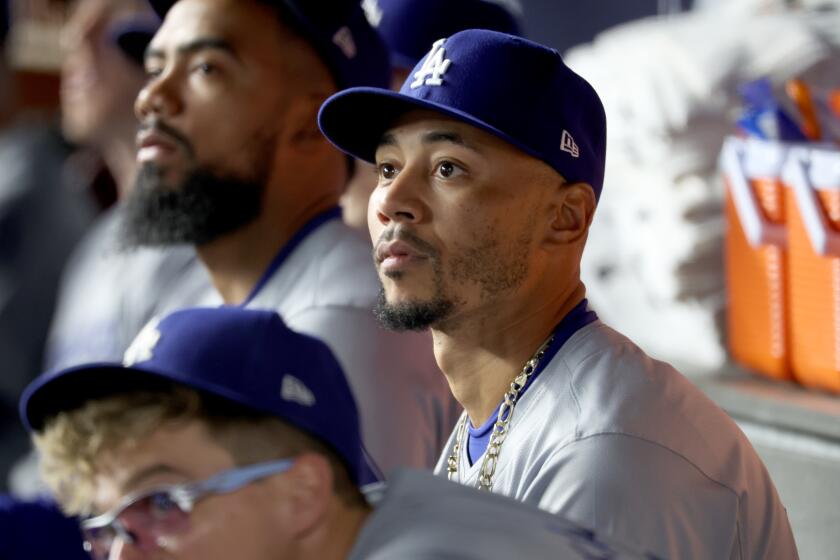Foul play
It happened more than 38 years ago, yet Manny Mota still can’t bring himself to talk about it.
“It’s very difficult,” the Dodgers coach and former All-Star outfielder said. “It brings up bad memories.”
“It” was a foul ball Mota lined into the seats down the first base line at Dodger Stadium during the third inning of an otherwise uneventful mid-May game against the San Francisco Giants in 1970. But what made this foul ball different from the thousands of others Mota hit into the stands during his 20-year big league career was that it hit a 14-year-old boy in the head, just above his left ear.
Five days later, the boy was dead.
“I felt guilty because I hit the foul ball,” Mota said quietly in Spanish. “And a young boy lost his life.”
It’s an occupational hazard all players share, because dozens of balls are hit into the stands at every major and minor league game. Sometimes thrown balls and bats wind up there too. Most of the time they bounce off seats and someone winds up with a souvenir.
Other times they don’t and someone winds up with a painful bruise or a broken bone. Or worse.
In April, Susan Rhodes of Sherman Oaks, sitting four rows behind the first base dugout at Dodger Stadium, suffered a concussion and facial injuries when a wooden bat swung by Todd Helton of the Colorado Rockies shattered, sending part of it into the stands. And last summer, first base coach Mike Coolbaugh of the double-A Tulsa Drillers was killed when he was hit in the head by a foul ball during a game.
Eventually, the games went on -- but it was never quite the same for everyone involved
“Every player, I don’t care how mean he is, if he hits a foul ball in the stands and somebody gets hit, they feel bad,” Dodgers second baseman Jeff Kent said. “When they get back in the batter’s box, I pretty much guarantee you that they’re not all 100% like they were before that pitch.”
That can disrupt an at-bat, a season, even a career.
Kent’s teammate Mark Sweeney was playing in the Cape Cod summer league when he hit a check-swing foul ball into the seats near the plate, hitting a woman in the arm.
“I’ll never forget it. She was wailing and screaming,” said Sweeney, who was ordered back in the batter’s box, where he feebly struck out. “It comes down to you don’t want anybody getting hurt. You’re a human being and you feel bad about that.
“That’s a hard thing to get over.”
At least 300 people each year are injured seriously enough by foul balls at professional baseball games that they require hospitalization, estimates Gil Fried, a lawyer and specialist in sports facility risk management at the University of New Haven in Connecticut. But an exhaustive study by authors Bob Gorman and David Weeks found that only two people -- the boy Mota hit and a 68-year-old man attending a minor league game in Miami in 1960 -- have been killed by foul balls at a professional baseball game.
And the courts have repeatedly held that neither the teams nor the players are responsible for the injuries thanks, in part, to the 145-word warning printed on the back of each ticket that says the fans assume “the danger of being injured by thrown bats, fragments thereof, and thrown or batted balls.”
A Massachusetts state court, ruling in the case of a woman who ran up nearly $500,000 in medical bills after being struck in the face by a foul ball at Boston’s Fenway Park, held that a person of “ordinary intelligence” may be assumed to know that “batters will forcefully hit balls that may go astray.” And more recently the Nevada Supreme Court dismissed the arguments of a woman who sued owners of the minor league Las Vegas 51s -- a Dodgers affiliate -- after she suffered facial injuries in a foul-ball accident.
That does little to assuage the players, however.
“We do care,” the Angels’ Torii Hunter said. “You still think about it at night, wondering how that kid is doing or how that man is doing that I hit. You feel sorry about it.”
Adds Angels broadcaster Rex Hudler, who played 13 seasons in the major leagues: “You don’t forget things like that. That’s kind of like the worst thing that can happen at a ballgame.”
As a boy attending his first big league game at San Francisco’s Candlestick Park, Hudler was standing near a girl who was hit in the head by a Willie McCovey line drive. He still carries that image with him.
“Forty-seven years old and I still remember it,” he said. “It was an ugly memory to keep.”
Which is why Hudler, who also played a season in Japan, wishes American baseball would adopt a Japanese custom and install protective screens down the foul lines as well as behind home plate.
“It kept people from getting their faces smashed and all that,” he said. “I felt like the fans were more protected. It worked well.”
Yet, few current players believe that will ever happen in the U.S., given the trend in ballpark construction to move seats closer to the action and the desire of spectators and owners alike to make the players more accessible.
The New York Mets’ Damion Easley, the father of four children, doesn’t look when he lines a ball into the stands. If he hit someone else’s kid, he says, he’d just as soon not know.
The Tampa Bay Rays’ Eric Hinske tries to look away too -- but with little success.
“When you’re on the field for 162 of them, you’re going to see it,” he said. “You see people get hit every day. They’re oblivious to the whole thing. They’re not even paying attention. And they got smoked all the time.
“I just try to look away as soon as possible so it doesn’t affect my at-bat.”
For those who don’t turn away in time, what they see can weigh on them.
When former Dodgers catcher Toby Hall was playing for Tampa Bay, he went into a mid-May series in Kansas City batting .326, having struck out only four times in April. But after hitting a 9-year-old boy with a foul ball in his second at-bat against the Royals, Hall struck out -- and fanned three more times over the next two days.
He hit only .224 over the next six weeks and didn’t recover until after the mid-July All-Star break.
Mota went through a similar funk. Before that Saturday game against the Giants, he was batting .339. Five days later, he was batting .310 and was so distraught he was benched.
Kent says many players will quietly send an usher or clubhouse attendant to check on the person who was hit, while others will make the visit personally.
The Rays’ Carl Crawford, who hit a spectator in the head during a spring-training game, gave the man a bat and still visits with him from time to time. Hunter gives away bats and signed baseballs and Hudler gave wristbands and batting gloves to people he hit.
Former Boston Red Sox outfielder Jim Rice once jumped into the stands along the first base line at Fenway Park to scoop up a bloodied 4-year-old who had been struck by a line drive, then rushed the boy into the trainer’s room. Doctors credited Rice’s quick thinking with saving the child’s life.
“You know the fans are vulnerable. These people that are coming to watch the game, they’re not trained to get out of the way of a ball,” Sweeney said.
“If something happens there’s nothing you can do about that situation. But you can handle yourself [afterward] in a manner that you should.”
Mota’s son, Jose, also a former major leaguer who now works for the Angels, once hit a foul so hard that the stitching on the ball left an imprint in a woman’s forehead.
“I used to go check on her the rest of the season,” he said. “I told her I was sorry and she said ‘What are you supposed to do?’ ”
The family of the boy Manny Mota hit was not so forgiving. Jose was 5 when that happened but says one of his earliest memories is of his panicked father rushing to the hospital, only to be barred from entering the boy’s room.
“He rarely talked of the incident after that,” Jose Mota said.
But he never forgot about it.
--
--
(BEGIN TEXT OF INFOBOX)
Foul-ups
Although there are no official records for foul balls, some written accounts say the mark belongs to Hall of Fame member Luke Appling, who, according to the accounts, fouled off 24 pitches from the New York Yankees’ Red Ruffing in one at-bat in 1940 before drawing a walk. Stats guru Bill James doesn’t buy that story, though, and says Roy Thomas, who played in the National League from 1899 to 1911, has the record with 22 foul balls in one at-bat.
Double-hitter
On Aug. 17, 1957, Hall of Fame member Richie Ashburn of the Philadelphia Phillies fouled off a pitch that struck Alice Roth, wife of Philadelphia Bulletin sports editor Earl Roth, breaking her nose. As Roth was being helped from the stands, Ashburn fouled off another pitch, striking Roth as she lay on a stretcher. She was not seriously injured.
Cubs lose!
Leading, 3-0, and five outs from reaching their first World Series in 58 years, the Chicago Cubs watched spectator Steve Bartman reach for a foul ball, deflecting it away from left fielder Moises Alou. Given new life, Luis Castillo drew a walk, starting an eight-run rally that propelled the Florida Marlins to the 2003 National League championship and earned Bartman infamy in Chicago. Alou said this spring he doubts he could have caught the ball.
Lovely gesture
Two years ago, Baltimore outfielder Jay Gibbons fouled off a pitch in the ninth inning of a game in Baltimore, striking his wife, Laura, in the ribs.
-- Kevin Baxter
More to Read
Are you a true-blue fan?
Get our Dodgers Dugout newsletter for insights, news and much more.
You may occasionally receive promotional content from the Los Angeles Times.










